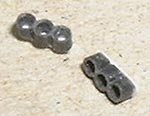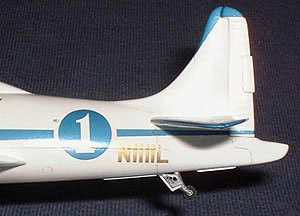| High Planes Bearcat Racer |
| |
 |
|
| In 1966 Lockheed test pilot Darryl Greenamyer won at the Reno
air races in this highly modified Bearcat which was the start of a 4 year
run of first place victories. On August 16th 1969, with a speed of 482.463
mph, he broke the world absolute propellor-driven speed record that had
been held since 1939 by Germany's Fritz Wendel in the Messerschmitt Me209
V1. The Bearcat would be modified many times over the years and sport several
different eye-catching paint jobs of which this 1966 blue and white scheme
is my personal favourite. And I don't even like vodka....
|
| |
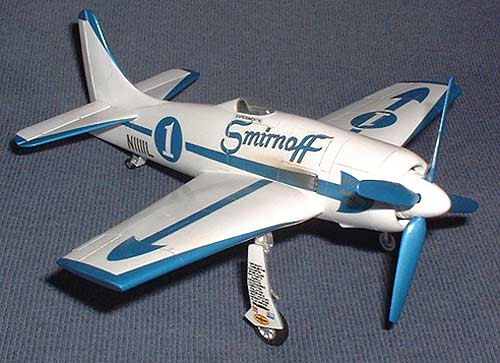 |
|
| I had no problems with the Bearcat's construction other than
the usual minor headaches associated with a limited run kit. The plastic
parts are very well moulded and sport fine recessed panel lines. So fine,
in fact, that I knew they would disappear under the many coats of white
paint needed to cover the lovely pale blue plastic so I decided to deepen
them with a scriber. In contrast to many racing aircraft, Greenamyer doesn't
seem to have bothered much with filling the panel lines and they are quite
noticeable in photos so I considered the re-scribing to be a necessary evil. |
| |
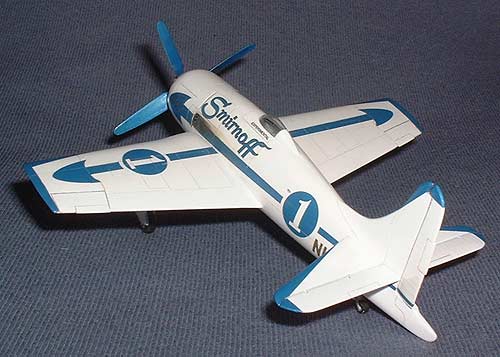 |
|
| The only other problem worth noting concerns the decals. Though
they are beautifully printed and go down well, the markings for the horizontal
stabilisers are not handed which means they will only work on the top of
the right and bottom of the left stabs without modification. Fortunately
this was very easy to overcome with a little experimentation. I floated
the incorrect decals off the backing paper and let them soak for a bit to
wash the glue off. Then it was just a matter of turning them upside down
(obviously this won't work on decals that are more than one colour or have
a white backing), placing them on some wet decal paper to "re-glue"
them on the correct side and then applying them in the normal fashion. I
also wish there had been more spare trim decal on the sheet as I had a hell
of a time trying to match that metallic blue colour in order to paint the
prop. In the end I used all the spare decal on the front of the blades and
cobbled together the remaining bits for the backs. It's a bit of a patchwork
affair but fortunately the decals blend together very well once they are
dry and a clear topcoat is applied. |
| |
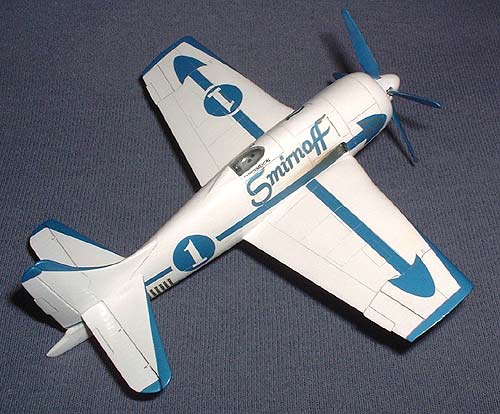 |
|
I removed the moulded on exhausts with a Dremel
and then made new ones from heat stretched tubing. These and the pitot were
the last items added. Exhaust and oil stains were airbrushed on with a very
thin mixture of Pollyscale clear flat and dark gray and then finished off
with brown pastel chalk. I was a little hesitant to add exhaust stains,
fearing it would detract from the pristine racy look but almost every picture
of this aircraft show it to have some staining and burnt paint behind the
exhausts so I thought I should give it a bit of weathering. In fact, in
some photos the dark brown exhaust trail goes all the way back to the rudder,
making it look dirtier than your average combat aircraft. In the end I was
quite happy with the slightly used finish - I think it kind of adds to the
potent look of the aircraft.
I should mention at this point that I damn near ruined the model when I
added a wash to the panel lines. My own personal preference when it comes
to panel lines is to err on the subtle side. I'm not a big fan of pre or
post shading, it looks heavy handed and unrealistic to me and I don't like
overbearing black washes either. So I picked what I thought would be a nice
medium gray enamel. Against the white paint however it ended up looking
almost black and the panel lines were jumping out at me. It looked bloody
awful in fact! My attempts to remove said wash met with failure and I was
beginning to think a sad end was in store for the model. In desperation
I applied a thin wash of Tamiya White over top of the gray and this had
the desired effect. It took three thin coats but I finally managed to tone
down the panel lines to an acceptable level. Whew!! Mental note: Medium
gray is not the way forward on white paint....
|
| |
 |
|
| White metal gear legs and a beautifully clear (but tiny!) vac formed canopy
complete this high quality offering from High Planes. If I were writing
for one of the major modelling magazines I guess I would finish off the
article with something like "High Planes' Smirnoff Bearcat is a colourful
and unusual addition to my collection and I highly recommend it". But
I'm not so I won't. ;-) |
|
|
Above left: Exhausts made from
heat stretched tubing. Bit of a close-up here, obviously.
Above right: Completely forgot about that little
ventral strake until the model was almost finished. Fortunately it was easy
to add from strips of .005" plastic. I just scribed a line where it
needed to go and then stuck it on with liquid cement. Tamiya White was brushed
on to match the rest of the paint. |
| |
| In addition to "Bent Throttles", the bi-monthly
newsletter put out by The
IPMS Racing & Record Aircraft SIG, main references used for this
model were "Reno Air Racing" by Michael O'Leary (Motorbooks International)
and WarbirdAeroPress.com
which has excellent photos of this and many other racing aircraft. |
| |
 Back to 1/72 Aircraft Main Back to 1/72 Aircraft Main |
| |





